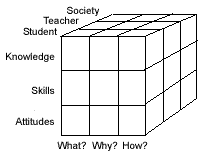| pA2
online © Copyright 2003 The British Pharmacological Society |
011P
University
of Manchester Autumn Meeting September 2003 |
|
P.K. Rangachari,
Department of Medicine, McMaster, University, |
Print Abstract Search PubMed
for: |
Teachers are inherently optimistic. They hope that their efforts would produce changes in their students, preferably for the better.
The domains in which changes ought to occur are in knowledge, skills and attitudes. The precise combination of desirable changes in the three components requires answers to the following questions: (A) What needs to be learned (CONTENT), (B) How is it to be learned (PROCESS) and (C) Why should this occur (IDEOLOGY). The answers are not however unambiguous since educational enterprises can be seen from more than one perspective-that of the teacher, the student and society at large (See Fig 1), generating potential conflicts.
Changes can be facilitated if both students and teachers are engaged in the process of learning and the locus of control shifts studentward. Teachers must be involved in several key components of the educational process-curriculum design, delivery and evaluation.
Problem-based learning (PBL) is only one of many ways to promote active learning. The approach is not, however, problem-free. It is resource intensive and the standard small group variant may be unworkable in many situations so alternatives are worth exploring. I describe below an attempt to adapt the principles of PBL to a large class (100 plus) withmyself as the sole tutor.
A toxicology course (Using Poisons) was designed for second year students in an Undergraduate Science Programme. The students participated in a simulation. Groups of 10 or 11 were formed and each Group given a specific task. They were required to learn the general principles of toxicology and apply them to the task at hand. I monitored their progress by weekly meetings and random audit of their logs. Students were expected to learn from each other, provide interim reports and write one major report by the end of the 12 week course. Each group was required to make a presentation that was assessed by the class. All students were expected to be prepared to present since the specific person was chosen at random and given a minute's notice. This ensured that all students became familiar with the material. The course received high ratings. By involving oneself in all phases of the educational process (curriculum design, delivery, evaluation), an active teacher can adopt problem-based learning to large classes. Exhilaration more than compensated for exhaustion.

Fig. 1: The Learning Cube